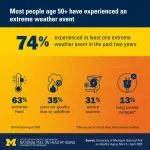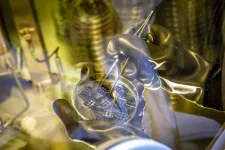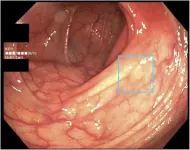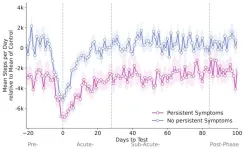(Press-News.org) Mammograms, with the help of artificial intelligence (AI) models, may reveal much more than cancer, according to a study being presented at the American College of Cardiology’s Annual Scientific Session (ACC.25). The findings highlight how these important cancer screening tools can also be used to assess the amount of calcium buildup in the arteries within breast tissue—an indicator of cardiovascular health.
The U.S. Centers for Disease Control and Prevention recommends that middle-aged and older women get a mammogram—an X-ray of the breast—to screen for breast cancer every one or two years. About 40 million mammograms are performed in the United States each year. While breast artery calcifications can be seen on the resulting images, radiologists do not typically quantify or report this information to women or their clinicians. The new study, which used an AI image analysis technique not previously used on mammograms, demonstrates how AI can help fill this gap by automatically analyzing breast arterial calcification and translating the results into a cardiovascular risk score.
“We see an opportunity for women to get screened for cancer and also additionally get a cardiovascular screen from their mammograms,” said Theo Dapamede, MD, PhD, a postdoctoral fellow at Emory University in Atlanta and the study’s lead author. “Our study showed that breast arterial calcification is a good predictor for cardiovascular disease, especially in patients younger than age 60. If we are able to screen and identify these patients early, we can refer them to a cardiologist for further risk assessment.”
Heart disease is the leading cause of death in the United States but remains underdiagnosed in women and there is also lagging awareness. Researchers said the use of AI-enabled mammogram screening tools could help identify more women with early signs of cardiovascular disease by taking better advantage of screening tests that many women routinely receive.
A buildup of calcium in blood vessels is a sign of cardiovascular damage associated with early-stage heart disease or aging. Previous studies have shown that women with calcium buildup in the arteries face a 51% higher risk of heart disease and stroke.
To develop the screening tool used for this study, researchers trained a deep-learning AI model to segment calcified vessels in mammogram images—which appear as bright pixels on X-rays—and calculate the future risk of cardiovascular events based on data obtained from the electronic health record data. The segmentation approach is what separates this model from previous AI models developed for analyzing breast artery calcifications. Researchers said the model is also strengthened by its use of a large dataset for training and testing, which included images and health records from over 56,000 patients who had a mammogram at Emory Healthcare between 2013 and 2020 and had at least five years of follow-up electronic health records data.
“Advances in deep learning and AI have made it much more feasible to extract and use more information from images to inform opportunistic screening,” Dapamede said.
Overall findings showed the new model performed well at characterizing patients’ cardiovascular risk as low, moderate or severe based on mammogram images. After calculating the risk of dying from any cause or suffering an acute heart attack, stroke or heart failure at two years and five years, the model showed that the rate of these serious cardiovascular events increased with breast arterial calcification level in two of the three age categories assessed—women younger than age 60 and age 60-80, but not in those over age 80. This makes the tool particularly well suited for providing early warning of heart disease risk in younger women, who can benefit more from early interventions, researchers said.
The results also showed that women with the highest level of breast arterial calcification (above 40 mm2) had a significantly lower five-year rate of event-free survival than those with the lowest level (below 10 mm2). For example, 86.4% of those with the highest breast arterial calcification survived for five years compared with 95.3% of those with the lowest level of calcification. This translates to approximately 2.8 times the risk of death within five years in patients with severe breast arterial calcification compared to those with little to no breast arterial calcification.
The AI model was developed as a collaboration between Emory Healthcare and Mayo Clinic and is not currently available for use. If it passes external validation and gains approval from the U.S. Food and Drug Administration, researchers said the tool could be made commercially available for other health care systems to incorporate into routine mammogram processing and follow-up care. The researchers also plan to explore how similar AI models could be used for assessing biomarkers for other conditions, such as peripheral artery disease and kidney disease, that might be extracted from mammograms.
Dapamede will present the study, “Risk Stratification of Adverse CV Events and Mortality in Women Using AI-Based Quantification of Vascular Calcifications,” on Monday, March 31, 2025, at 9:00 a.m. CT / 14:00 UTC in S401C.
ACC.25 will take place March 29-31, 2025, in Chicago, bringing together cardiologists and cardiovascular specialists from around the world to share the newest discoveries in treatment and prevention. Follow @ACCinTouch, @ACCMediaCenter and #ACC25 for the latest news from the meeting.
The American College of Cardiology (ACC) is the global leader in transforming cardiovascular care and improving heart health for all. As the preeminent source of professional medical education for the entire cardiovascular care team since 1949, ACC credentials cardiovascular professionals in over 140 countries who meet stringent qualifications and leads in the formation of health policy, standards and guidelines. Through its world-renowned family of JACC Journals, NCDR registries, ACC Accreditation Services, global network of Member Sections, CardioSmart patient resources and more, the College is committed to ensuring a world where science, knowledge and innovation optimize patient care and outcomes. Learn more at ACC.org.
###
END
DALLAS, March 20, 2025 — Stroke is the fourth leading cause of death in India and the fifth leading cause of disability.[1] To establish a coordinated system of care for stroke in the country, Apollo Hospital in Hyderabad, Telangana, and Aster Hospital in Calicut, Kerala, are the first in India to be certified as Comprehensive Stroke Centers by the American Stroke Association.
Launched in India last year, certifications from American Stroke Association, a division of the American Heart Association, devoted to a world ...
Nearly 3 out of every 4 older Americans have experienced at least one extreme weather event in the last two years, a new University of Michigan poll finds. And living through such an event appears to make a big difference in how they view the potential impact of climate change on their health.
The new findings from the National Poll on Healthy Aging show that 59% of people aged 50 and over are concerned about how climate change could affect their health.
The percentage expressing concern was even higher among those who had recently lived through a weather ...
Complex materials such as organic semiconductors or the microporous metal-organic frameworks known as MOFs are already being used for numerous applications such as OLED displays, solar cells, gas storage and water extraction. Nevertheless, they still harbour a few secrets. One of these has so far been a detailed understanding of how they transport thermal energy. Egbert Zojer’s research team at the Institute of Solid State Physics at Graz University of Technology (TU Graz), in collaboration with colleagues from TU Vienna and the University of Cambridge, has now cracked this ...
Women with polycystic ovary syndrome (PCOS) find it harder to get pregnant, have more frequent miscarriages and have a higher risk of developing endometrial cancer. Now, in a new study published in Nature Medicine, Swedish researchers have shown that the uterine lining of these women differs in terms of both the composition of individual cells and gene expression. The results open the door to new drug treatments.
PCOS is the most common hormonal disorder affecting 11-13% of women of reproductive age. Women with the syndrome have difficulty getting pregnant and are at increased ...
As animals experience new things, the connections between neurons, called synapses, strengthen or weaken in response to events and the activity they cause in the brain. Neuroscientists believe that synaptic plasticity, as these changes are called, plays an important role in storing memories.
However, the rules governing when and how much synapses change are not well understood. The traditional view is that the more two neurons fire together, the stronger their connection becomes; when they fire separately, their connection weakens.
New research ...
Scientists from the RIKEN Center for Emergent Matter Science (CEMS) and collaborators have discovered a groundbreaking way to control superconductivity—an essential phenomenon for developing more energy-efficient technologies and quantum computing—by simply twisting atomically thin layers within a layered device. By adjusting the twist angle, they were able to finely tune the “superconducting gap,” which plays a key role in the behavior of these materials. The research was published in Nature Physics.
The superconducting gap is the energy threshold required to break apart Cooper pairs—bound electron pairs that enable superconductivity at low temperatures. ...
New Haven, Conn. — Advances in the gene-editing technology known as CRISPR-Cas9 over the past 15 years have yielded important new insights into the roles that specific genes play in many diseases. But to date this technology — which allows scientists to use a “guide” RNA to modify DNA sequences and evaluate the effects — is able to target, delete, replace, or modify only single gene sequences with a single guide RNA and has limited ability to assess multiple genetic changes simultaneously.
Now, however, Yale scientists have developed a series of sophisticated mouse models using CRISPR (“clustered regularly ...
The American Gastroenterological Association (AGA) released a new clinical guideline making no recommendation — for or against — the use of computer-aided detection systems (CADe) in colonoscopy. A rigorous review of evidence showed that artificial intelligence-assisted technology helps identify colorectal polyps. However, its impact on preventing colorectal cancer — the third most common cancer worldwide — remains unclear.
Colonoscopy, performed more than 15 million times annually in the U.S., is an effective tool for detecting and preventing colorectal cancer. CADe systems have been shown to improve polyp detection ...
For the first time scientists have identified promising drug candidates that bind irreversibly with a notoriously “undruggable” cancer protein target, permanently blocking it.
Transcription factors are proteins that act as ‘master switches’ of gene activity and play a key role in cancer development. Attempts over the years to design “small molecule” drugs that block them have been largely unsuccessful, so in recent years scientists have explored using peptides – small protein fragments – to block these “undruggable” targets.
Now researchers from the University of Bath have for ...
[Vienna, 19.03.2025]—Between April 2020 and December 2022, over 535,000 people in Germany downloaded and activated the Corona Data Donation App (CDA). Of these, more than 120,000 voluntarily shared daily data from their smartwatches and fitness trackers with researchers, providing insights into vital functions such as resting heart rate and step count.
“These high-resolution data served as the starting point for our study,” explains CSH researcher Katharina Ledebur. “We were able to compare vital signs in 15-minute intervals before, during, and after a SARS-CoV-2 infection.”
Higher Resting Heart Rate ...



